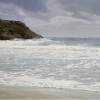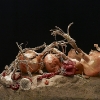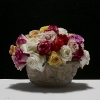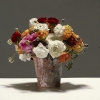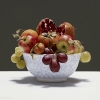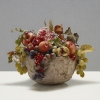Luciano Ventrone
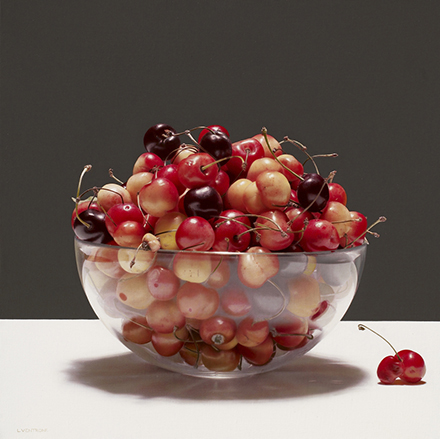
Tra gli artisti italiani maggiormente conosciuti a livello internazionale, Luciano Ventrone ha esposto nei più importanti musei e gallerie internazionali, da Roma a Milano, da Londra a Singapore, da New York a Mosca e San Pietroburgo.
L’artista dimostra da sempre la sua abilità nel trattare i colori e la pittura. Nella tecnica di Ventrone la fotografia è un punto di partenza, un punto dal quale parte l’astrazione del soggetto che si priva del suo essere materia per essere vissuto solo attraverso la luce. Lavorando direttamente dalla fotografia, Ventrone è in grado di cogliere dettagli non visibili all’occhio umano. Nelle sue opere l’artista crea mondi suggestivi carichi di vissuti e di emozione. La scelta dei soggetti lo lega ai grandi pittori del passato, tuttavia è la sua attenzione per l’applicazione della pittura, il suo trattamento del colore e della luce che lo pongono tra i contemporanei.
“Lo studio della pittura - sostiene Ventrone - non è la mera rappresentazione dell’oggetto ma è colore e luce: i giusti rapporti fra le due cose danno la forma nello spazio. Il soggetto non va visto come tale ma astrattamente.”
Nel 1983, un articolo di Antonello Trombadori pubblicato su «L’Europeo» induce lo storico dell’arte Federico Zeri ad interessarsi dell’artista suggerendogli di affrontare il tema delle nature morte. E’ qui che inizia la lunga e ancora non completa ricerca sui vari aspetti della natura, catturando particolari sempre più dettagliati e quasi invisibili.
E’ questa sua ricerca “dell’invisibile” che ha destato l’attenzione di tutti i più importanti critici contemporanei ad iniziare da Zeri, ed a seguire con Soavi, Tassi, Bonito Oliva, Sgarbi, Di Capua, Trombadori, Zavoli, Lucie-Smith, Crespi, Buscaroli.
Cenni biografici
Luciano Ventrone nasce a Roma nel 1942, frequenta il Liceo Artistico di Roma. Dopo il diploma conseguito nel 1964, si iscrive alla facoltà di Architettura che frequenterà sino al 1968; in quell’anno, decide di abbandonare gli studi per dedicarsi interamente alla pittura.
Luciano Ventrone, Il mondo parallelo (documentario)
Biography
Luciano Ventrone was born in Rome in 1942, he attended Liceo Artistico in Rome. After graduation in 1946 he started studying Architecture. In 1968 he left the University and focused on painting.
Even though Luciano Ventrone is internationally recognized as one of the master realist painters of his generation, he believes that his works are really about optics: “Painting is not about the mere representation of an object, but its color and light,” he says. “The subject cannot be seen as it is but as an abstract element.” Ventrone studied at Rome’s Liceo Artistico and—in spite of experimenting with avant-garde methods—garnered attention for his academic realism and attention to anatomical detail; his life drawings would be published in a university textbook on human anatomy. Ventrone’s paintings still frequently feature nudes, as well as carefully arranged still lifes. For each of his works, Ventrone carefully stages his subject under bright studio lights, and photographs the arrangement for painting reference.
Luciano Ventrone’s paintings ‘invite a mood of pure contemplation’ from the viewer; they are works of masterful skill and supreme aesthetic beauty. Though he admits sharing a strong affinity for the work of Caravaggio, Ventrone does not consider himself a realist painter in the traditional sense. He paints real objects but, because of his utilisation of certain contemporary techniques as part of the artistic process, the objects depicted are transported into a metaphysical, hyper-real context. What we see in a Ventrone painting is not ‘real’ because it is not what we would see were we to look with the naked eye - We see more. Ventrone shows us things more fully and more clearly than they appear to us in reality; everything is in focus, everything can be scrutinised. He allows us to notice every blemish and admire every curve of flesh in a piece of fruit or on a naked female form. Set against monochromatic backgrounds of white, grey or black, the subject is lit from multiple angles, allowing for a full and objective appraisal of what we behold. Thus, what Ventrone shows us is, in his own words, a ‘Mondo Parallelo’ or ‘Parallel World’; a Universe that shares the same starting point but a different system of evolution to our own.
Benedicenti, Carta, Ventrone
Mimesis, 2011 - pp. 36
prezzo € 8,00
